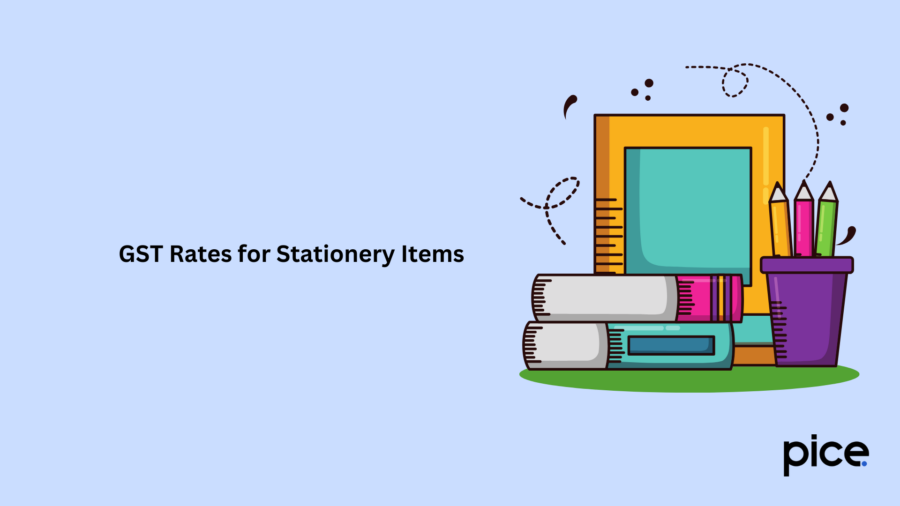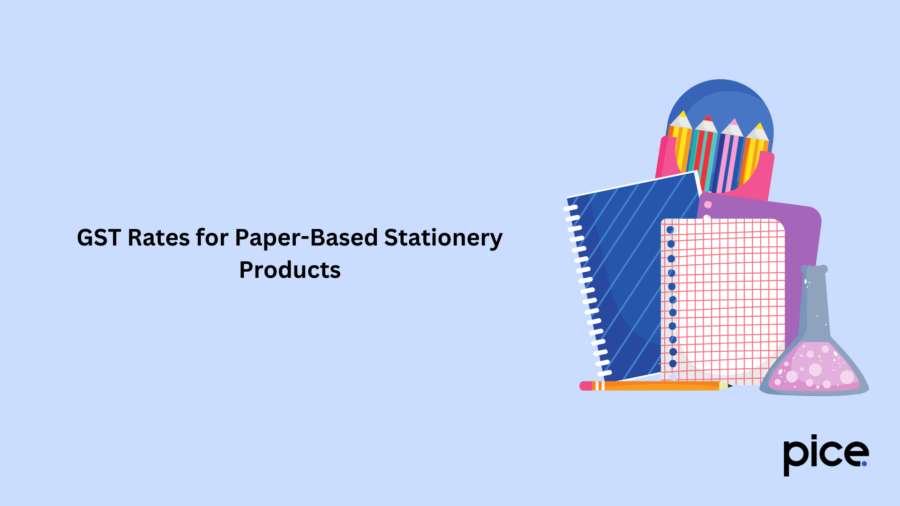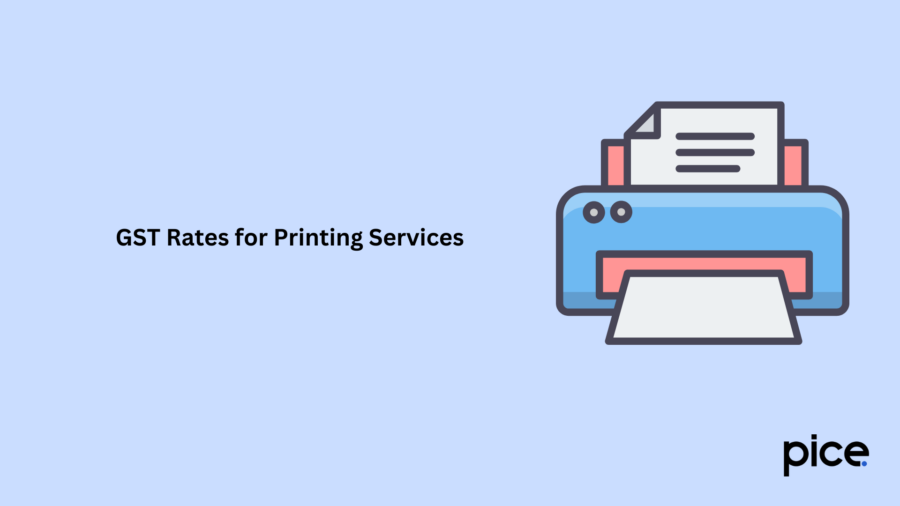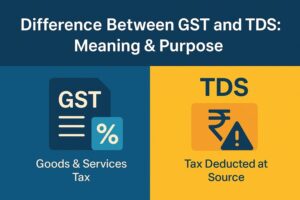Impact of GST on Paper Industry: GST Rates on Pens, Paper & More
- 10 Feb 25
- 9 mins

Impact of GST on Paper Industry: GST Rates on Pens, Paper & More
Key Takeaways
- GST reshaped stationery taxation, affecting prices and compliance.
- Stationery items attract GST from NIL to 18% based on classification.
- Paper-based stationery and printing services have separate GST rates.
- Businesses can claim ITC on stationery used for commercial purposes.
- GST simplifies taxes but adds compliance challenges for retailers.
Goods and Services Tax (GST) has revolutionised the taxation landscape in India, impacting various industries, including the stationery sector. Stationery items, ranging from basic pencils to advanced office supplies, play a vital role for individuals and businesses alike.
With the implementation of GST, these products are now subject to a specific tax structure that has brought both challenges and benefits to manufacturers, suppliers, and consumers alike. Grasping the impact of GST on paper industry along with stationery items is crucial to learn about its broader economic effects.
GST Rates for Stationery Items

The GST applicability on stationery items in India varies depending on the type of product. The 47th GST Council revised GST rates for certain stationery items, including pencil sharpeners, printing and drawing inks, cutting blade knives, paper for aseptic packaging, paper knives, and marking or drawing instruments, increasing the rate from 12% to 18%.
However, at the 49th GST Council meeting on 18th February 2023, the GST rate on pencil sharpeners was reduced from 18% back to 12%, restoring its original rate.
Although some exceptions exist, most stationery items are categorised under Chapter 96 of the HSN code. Items like slates, chalk sticks, and slate pencils are exempt from GST. Below is a table summarising the GST rates for stationery items listed under Chapter 96:
| Product | GST Rate | HSN Code |
| Brushes, paint pads, arranged strands and clusters for creating brushes, and rollers (excluding brushes, which are created by bundling twigs or plant materials, regardless of the presence or absence of handles) | 18% | 9603 [Except 9603 10 00] |
| Felt-tipped, stylograph pens, fountain pens, markers, ballpoint pens and other porous-tipped pens, and other pens, pencils and similar holders, duplicating stylos, parts like clips and caps of the preceding articles, excluding those under heading 9609 | 9608 | |
| Board surfaces for writing or drawing, whether framed or not | 9610 00 00 | |
| Ribbons for typewriters or similar devices, which are used to create impressions, whether they come on spools or in cartridges and ink pads, regardless of whether they include a box, inked or not. | 9612 | |
| Monopods, bipods, tripods, and similar articles | 9620 00 00 | |
| Hand-operated stamps for dating, numbering, or sealing, as well as similar devices for embossing or printing labels, designed for manual use, hand printing sets and hand-operated composing sticks that accommodate such composing sticks. | 9611 | |
| Propelling or sliding pencils, pastels, crayons, tailor’s chalk and drawing charcoals | 12% | 9608, 9609 |
| Revenue or postage stamps, stamp-postmarks, first-day covers, postal stationery, whether or not used, other than those under heading 4907 | 5% | 9704 |
| Slates | NIL | 9610 00 00 |
| Chalk sticks and slate pencils | 9609 |
GST Rates for Paper-Based Stationery Products

Apart from Chapter 96, several paper-based stationery items are classified under HSN Code Chapters 48 and 49, attracting varying GST rates.
Additionally, the 47th GST Council meeting revoked the GST exemption previously available for certain printed stationery items, such as hydrographic charts, topographical plans, wall maps, atlases, and globes. These items are now subject to a 12% GST rate.
The table below outlines the GST rates and HSN Codes for paper-based stationery items following these recent changes:
| Product | GST Rate | HSN Code |
| Vegetable parchment, tracing paper, and various other transparent or varnished translucent papers (excluding glassine and greaseproof paper) | 18% | 4806 [Except 4806 20 00, 4806 40 10] |
| Self-copy paper, carbon paper, and all other transfer or copying papers, even coated or impregnated paper, printed or in rolls or sheets | 4809 | |
| Paperboard, paper, webs of cellulose wadding and cellulose fibres, whether covered, surface-coloured, coated, surface-decorated in rolls, impregnated, printed, or rectangular or square sheets, of any size (except those under 4810, 4809, and 4803) | 4811 | |
| Carbon paper, self-duplicating paper, and various other transfer or copying papers (except those classified under heading 4809), as well as duplicator stencils and offset printing plates, made of paper, whether loose or packaged. | 4816 | |
| Envelopes, postcards, correspondence cards, and letter cards of paper or paperboard (excluding those under HSN 4817 30, including writing blocks) | 4817 [Excluding 4817 30] | |
| Cartons, boxes, cases, bags, and other containers that are made of paperboard, paper, cellulose wadding or webs of cellulose fibres, box files, letter trays, used in shops, offices, etc. | 4819 | |
| Letter pads, registers, order books, account books, diaries, receipt books, memorandum pads, interleaved carbon sets, binders (loose-leaf or other), blotting-pads, folders, file covers, book covers, manifold business forms, etc. | 4820 | |
| Paperboard and uncoated paper for writing, various graphing purposes, hand-made paper and paperboard, non-perforated punch tape paper, printing, and punch cards, in the form of rolls or rectangular or square sheets, of any size (excluding those under 4803 or 4801) | 12% | 4802 |
| Uncoated kraft paperboard and paper whether in sheets or rolls, (except those under 4803 or 4802) | 4804 | |
| Other uncoated paper and paperboard whether in rolls or sheets, that have not undergone any processing or alteration except for the methods in Note 3 of Chapter 48 | 4805 | |
| Glassine papers | 4806 40 10 | |
| Greaseproof papers | 4806 20 00 | |
| Composite paper and paperboard created by adhering layers together using an adhesive. It is not treated with surface coatings or impregnated or internally reinforced. This material comes in the form of rolls or sheets. | 4807 | |
| Paper and paperboard, perforated, crinkled, creped, embossed, or corrugated in rolls or sheets (except those under 4803) | 4808 | |
| Paper and paperboard with China clay, kaolin, or other inorganic material coatings, whether they have a binder or not, can be surface-colored or not, printed or surface decorated. They can be found in rolls or in square or rectangular or sheets of various sizes. | 4810 | |
| Pouches, writing compendiums, boxes, and wallets made of paper or paperboard | 4817 30 | |
| Graph book, exercise book, and notebooks for laboratory | 4820 | |
| Printed maps, atlases, topographical plans hydrographic charts, globes, and wall maps | 4905 |
GST Rate for Stationery Products Made of Metal
The GST rate for stationery products made from metal is subject to 18% GST. The list of these items along with their HSN codes is mentioned below:
| Product | HSN Code |
| Paper rests, paper trays, card-index cabinets, office-stamp stands, filing cabinets, pen trays, and metal-based desks or office equipment, except office furniture | 8304 |
| Accessories for looseleaf files or binders, including clips for letters, indexing tags, paper clips, and strips of base metal staples | 8305 |
| Sign plates, nameplates, and other similar plates that are made of base metal | 8310 |
| Machines for pencil sharpening | 8475 |
GST Rates for Printing Services

Printing goods fall under HSN Code Chapters 48 and 49 while printing services are classified under Chapter 99, titled ‘Manufacturing services on physical inputs (goods) owned by others.’ Below is a breakdown of the applicable GST rates for printing services.
| Product | GST Rate | HSN Code |
| Printing, publishing, and production services | 18% | 9989 |
| Services related to employment in the field of printing products that are categorised under Chapters 48 or 49 and attract an IGST of 12% | 12% | 9988 |
| Services connected to the processing or treatment of someone else's goods that pertain to the printing of items classified under Chapters 49 or 48 are subject to a 12% IGST. | 9988 | |
| Services involving the treatment or processing of someone else's goods, concerning the printing of journals, books, Braille publications, newspapers, and all items classified under Chapters 48 or 49, which are either exempt from IGST or subject to a 5% tax. | 5% | 9988 |
| Work associated with the printing of various materials such as books (including Braille), periodicals, newspapers, journals, and other items categorised under Chapters 48 and 49, which are either not subject to IGST or have a 5% tax rate | 9988 |
Input Tax Credit (ITC) for Stationery
You can claim Input Tax Credit (ITC) under GST, as long as these items are used for business purposes. To be eligible for ITC, businesses must meet the following conditions:
- The business must have received the goods or services.
- They should have a tax invoice or debit note from the supplier.
- The relevant GST returns should be filed by the business.
- The supplier must have remitted the tax collected on the supply to the government.
GST Impact on Stationery Businesses
The implementation of GST has simplified the tax framework for stationery goods, making it easier to comprehend tax responsibilities. It has also led to fluctuations in prices for some products, particularly those subjected to higher GST rates.
Conclusion
The implementation of GST has streamlined the taxation process for the stationery sector. However, it has also introduced challenges, such as fluctuating product prices and increased compliance requirements, especially for small retailers. The impact of GST on the paper industry highlights its significant role in shaping pricing strategies and enhancing operational efficiencies within this sector.
💡If you want to streamline your payment and make GST payments via credit card, consider using the PICE App. Explore the PICE App today and take your business to new heights.
 By
By 
















